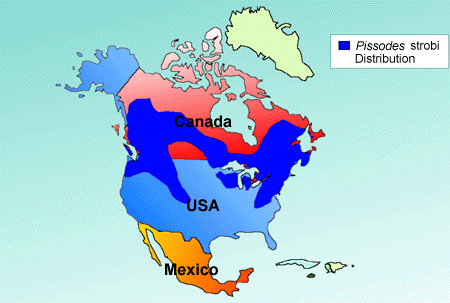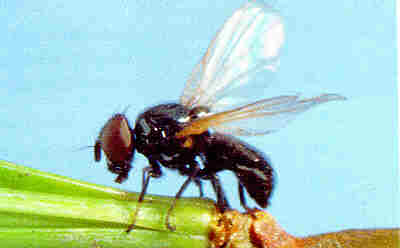Terminal Weevils
General Biology of Terminal Weevils
| Hosts & Range | |||||||||||||||||||
| Biology / Life Cycle | |||||||||||||||||||
| Tree Response | |||||||||||||||||||
| Population Dynamics | |||||||||||||||||||
| Signs & Symptoms | |||||||||||||||||||
| Tree Resistance | |||||||||||||||||||
| Damage | |||||||||||||||||||
| Hazard Rating | |||||||||||||||||||
Management
|
Differences
|

Source: http://www.fs.fed.us/r1-r4/spf/fhp/field_guide/images/fig156.jpg
General Biology of Terminal Weevils in BC
|
Order: Coleoptera
| |||||||||||||
|
Adults feed on terminal leader - no
significant damage / larva feed under bark and are damaging | |||||||||||||
|
Simplified life cycle
|
Spruce Terminal Weevil (a.k.a. White Pine Terminal Weevil)
In natural stands this can be a 'rare' insect pest - small openings, shaded conditions, small leaders. However, in the 1970's we established large plantations of S ... which meant large food source in a warm area (more about heat sums later)
|
In BC - Ss, Se, Sw (Sb, Pl) | |
|
Out east, (who cares ... well ...) - pines (white, red, jack, scots) and spruce (white, red, norway, colorado, black) |

Source: http://www.pfc.forestry.ca/entomology/weevil/about_e.html
Note: not on Queen Charlotte Islands
|
Adults
| |||||||||||
|
Eggs hatch in ~ 2 weeks | |||||||||||
|
Larvae
"Tastes like chicken"
| |||||||||||
|
Pupae
| |||||||||||
|
Adults
|
Life Cycle Diagram from PFC
Life History from FPC Guidebook
|
resin (more on this later) - attempt to 'pitch out' the attack | |
|
lateral assumes dominance ... leads to fork or crook
Roughly 40% - no damage 10% - minor scar 45% - minor fork / crook 5% - major fork / crook
Actual impact depends on site productivity good sites - trees 'over grow' the defects more often poor sites - greater damage |

Source: http://www.for.gov.bc.ca/tasb/legsregs/fpc/fpcguide/weevil/figure3.htm
|
attack starts at about 5 years (~1/2 m tall) | |||||||||||||
|
peaks at 15 - 30 years (2 - 10 m tall)
| |||||||||||||
|
then population declines
| |||||||||||||
|
most trees attacked within 5 m of nearest attacked tree |
|
leaders in spring - feeding punctures with droplet of resin | |||||||
|
leaders previously attacked
| |||||||
|
older attack
|

Source: http://www.for.gov.bc.ca/tasb/legsregs/fpc/fpcguide/weevil/figure4.htm
|
inside leader
| |||||
|
adult - rusty brown with cream splotches |

Source: http://www.for.gov.bc.ca/tasb/legsregs/fpc/fpcguide/weevil/table3.htm
Sheppard's Crook

Source:http://1.bp.blogspot.com/_8xC9bwq6AVU/SfGU0pArUYI/AAAAAAAAH9c/2hQ_vhh1axM/s400/wpw5.jpg
feeding larva

Source: http://www.forestry.ubc.ca/fetch21/FRST308/lab4/pissodes_strobi/larvae2.jpg
Chip cocoons

Source: http://www.fs.fed.us/r1-r4/spf/fhp/field_guide/largeimages/fig158-x.jpg
Exit Holes

Source: http://www.fs.fed.us/r1-r4/spf/fhp/field_guide/images/fig155.jpg
Adult

Source: http://www.forestryimages.org/images/192x128/1306048.jpg
Adult

Source: http://www.forestryimages.org/images/192x128/1306048.jpg
| repellants - (antixenosis) terpenes at high concentrations deter feeding and oviposition | |
| juvenile hormone - (antibiosis) causes ovary atrophy (remain small and undeveloped), female cannot lay eggs | |
| traumatic resin - (antibiosis) has mono-terpenes (makes the resin more fluid and better
able to 'soak' the egg site) | |
| we are breeding for these traits |
| deformity (= value) | |
| growth loss (= volume) | |
| avenue for decay (= volume) | |
| loss of preferred species (= value) | |
| deformity ... remember |
Roughly
40% - no damage
10% - minor scar
45% - minor fork / crook
5% - major fork / crook
Actual impact depends on site productivity
good sites - trees 'over grow' the defects more often
poor sites - greater damage
|
growth loss (table of volume loss related to attack % and attack duration) |
| Attack % / Year | 10 Years | 20 Years | 30 Years | 40 Years |
| 10% / yr | 5% | 10% | 15% | 20% |
| 20% / yr | 15% | 20% | 25% | 30% |
| 30% / yr | 20% | 30% | 35% | 40% |
| 40% / yr | 20% | 30% | 35% | 40% |
ball park figures: likely 15-25% volume loss, but could be in the range of 5 - 40%
2 methods:
|
Hazard Rating - Coast
| ||||||||||||||||||||||
Brushing
|
Fertilize - are you nuts? |
Spacing
| |||||||||||||||
Prune?
| |||||||||||||||
Rehabilitation - means cutting all the trees down and starting over ...
pretty drastic
|

Direct Control
|
Differences are highlighted
Hosts & Range
| |||||||||||||||||||||
Biology
| |||||||||||||||||||||
|
Signs & Symptoms | |||||||||||||||||||||
Hazard
| |||||||||||||||||||||
Management
|
It is obvious that the pine terminal weevil is ... (what?)

